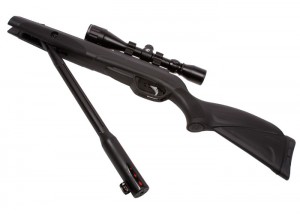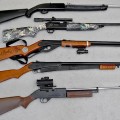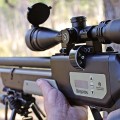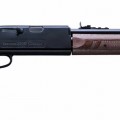Some of the links below are affiliate links, meaning, at no additional cost to you, we will earn a commission if you click through and make a purchase.
Air rifle is a kind of air gun that usually uses a pneumatic type of firing, which basically means utilizing gas or compressed air to propel loaded projectiles. Depending on the ammunition used, from pellets to BBs (ball bullet or ball bearing), your handling of air rifles could vary.
Air rifles has been around for a long time now, and is considered as a useful tool for recreational or hunting activities. Although some may still consider them as deadly weapons, air rifles are actually a good way to introduce people into the proper use of a gun, which limits the likelihood of misusing a real, and far more dangerous, firearm.
To start with an air rifle, you can consider our top 5 air rifles under $200 or read our buying guide for air pistols if that’s more your type of air gun.
Regardless of your purpose for getting into air rifles, as long as it’s within law, you need to be aware of your responsibilities for possessing such item. And to do that, you need to learn the basics, which this article is about.
The Anatomy of an Air Rifle
If you’ve never held an air gun before, or any gun in general, chances are you’re also unfamiliar with its parts, unless you’ve learned it through other means. Before you indulge into your trigger finger, it’s best to know what you’re pulling, holding, aiming, and firing.
This type of air gun essentially has the same, or most, parts of any basic rifles. There’s the muzzle, barrel, scope, trigger and trigger guard, all the way back to the stock.
Some also have a front sight and a rear sight. Furthermore, an air gun won’t be an air gun without its power source- air. And just like the type of ammo used, the kind of air compression mechanism employed to fire such projectiles can also affect your air gunning experience. Here are the usual means of propulsion used by air guns:
-
Pneumatic
Pneumatic air rifles are those that principally rely on compressed air as propellant. It could either come in pre-charged or in pump-up style. Each has their own unique process of harnessing air, but both operates fundamentally the same.
The pump-up type of pneumatic firing is something that air gun holders are most familiar with, at least for those in the US. Air build-up is achieved by using a pumping lever that is commonly placed around the forearm section of the air gun. However, because you exert time and effort just to pump-up for each shot, this can prove quite taxing in both your energy and movement.
As for the pre-charged pneumatic (PCP), shot-by-shot pumps are rid of. Instead, you get multiple shots with each pump, thanks to a now larger air reservoir. Recharging PCPs is also a much simpler task as it is compatible to high-pressure hand pumps and SCUBA tanks.
PCP (Pre-charged Pneumatic) air guns are considered the most powerful and objectively precise. However, they are usually made with top-quality components and fine workmanship, making them quite pricey, especially if you combine it with the cost of procuring needed accessories like pumps or tanks. It’s more of an investment, but one that is duly rewarded.
-
CO2 Powered
This type of air source uses CO2-filled canisters to power most types of air guns. It usually comes in 12-gram cartridges, but bigger sizes are also available.
With a no-pump method and being easy to cock, CO2-powered air guns are definitely one of the easiest to use, and also allows for a more continuous firing. If you prefer efficiency over the somewhat expensive cost, then this one is for you.
-
Spring Piston
Spring Piston is by far the most common type of air gun power source known to adults. It uses a piston and coiled spring in its chamber, which when cocked compresses the spring, and then decompresses to thrust the piston forward along with the trapped air, after the trigger is pulled, thus propelling the ammunition.
This process also involves different kinds of cocking, depending on the gun, from side- to barrel-cocking or underlever. These types of air guns are very consistent when it comes to shot-to-shot scenarios, and packs quite the punch paired with high accuracy, so if you’re all about every single shot, this may appeal to you more.
-
Gas Piston
Gas piston, or gas strut or gas ram, as others may call it, are essentially similar to the abovementioned spring piston. But instead of a coiled spring, the gas piston integrates a gas-filled cylinder.
This gas-filled cylinder already contains compressed air inside, which is only further pressurized through cocking and subsequently forces the piston onward when the trigger is pulled. This air gun propulsion method tends to last longer compared to spring pistons since it has no steel spring in place that will eventually wear down and lose power with each use.
Know What You’re Firing, and What You’re Shooting At
There are different types of air gun bullets you can choose from, and by getting familiar with them, you can narrow down your list to find which ammunition will best fit your style of shooting and the type of rifle you own.
In general, BBs and pellets are the two main types of air gun rounds that you can procure, each of which has their own sub-variations, with the latter having the most diversity.
BBs (ball bearing/ball bullet) are usually made of steel and are spherical in shape. Because of these two characteristics, BBs are likely to perform poorly with aerodynamics which affects accuracy, not to mention it ricochets easily. This makes BBs better suited for mostly backyard plinking and other similar recreational pursuits (for instance the NRA air gun competition).
When it comes to pellets, they are more ideal for hunting and highly adaptable to many situations. In contrast to the lone spherical form of BBs, pellets can take on various shapes and sizes. And thanks to the influence of technology and some airflow studies, pellets now has different kinds for different setups. From round noses, pointed pellets, hollow points, to wad cutters, PBA pellets, and more, you definitely have more options with pellets than with BBs.
There are still a lot more you can learn about owning and using air rifles. But being aware of the basics is always the best start to almost anything, the rest you can experience for yourself along the way.










at 1:15 pm
Thanks for going over some of the basics of air rifles and air guns. I actually didn’t know about CO2 powered guns, and that they are some of the easiest to use, allowing for continuous firing. It would be interesting to learn more about the different techniques used when wielding guns like these, and some safety measures used to protect people.
at 7:45 pm
Hi Taylor,
Thanks for your great comment! We’ll think about your suggestion and might write a nice article about that! Dan.